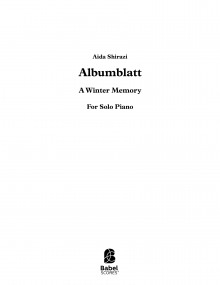Tülbend
for ensemble
14,42 €
Version numérique (+0,00 €) à télécharger
Version papier (+16,20 € impression et livraison ). Colissimo7-14 days aprox.
Chez BabelScores, quand vous achetez une partition, vous pouvez ensuite contacter directement le compositeur ici même !
Caractéristiques
Region
Europe
Estimated Duration
6 - 10min
Date
2012
ISMN : 979-0-2325-2200-5
In Stock
Notes sur cette pièce Premiered by the Nieuw Ensemble; Michalis Cholevas, ney; Jussi Jaatinen,
conductor.
The title of the piece etymologically relates with the word tulip. The
flower plays an important role in the piece as a metaphor at various
levels. Certain materials of the entire piece are taken from 18th century
Turkish woman composer Dilhayat Kalfa's masterpiece Evc'ârâ Saz Semaîsi, an
exquisite work from the period of Ottoman history which is known as the
Tulip Era. the pitch reservoir for each movement is divided into three
groups each of which takes different roles named after the anatomical parts
of a tulipa.
Listening through the six movements can be considered as observing
different tulips, or a particular representation of tulips (perhaps a
series of ebrû [Turkish art of paper marbling] or Bollongier's still life
paintings). Such an observation requires a different listening mode which
is focused in NOW in order to observe the aesthetics of the fleeting
moments. The form is reduced into a mere shape, far from being a
psychoacoustic tool to guide the listener's attention towards a formal
goal—there is no goal to be reached. Within this environment, the ney
taksims (improvisations) appear as “traditional abstractions” of the source
work, pairing with the “contemporary abstractions” carried by the rest of
the composition.
Ajouter à une playlist
- Identifiez-vous pour créer une liste
conductor.
The title of the piece etymologically relates with the word tulip. The
flower plays an important role in the piece as a metaphor at various
levels. Certain materials of the entire piece are taken from 18th century
Turkish woman composer Dilhayat Kalfa's masterpiece Evc'ârâ Saz Semaîsi, an
exquisite work from the period of Ottoman history which is known as the
Tulip Era. the pitch reservoir for each movement is divided into three
groups each of which takes different roles named after the anatomical parts
of a tulipa.
Listening through the six movements can be considered as observing
different tulips, or a particular representation of tulips (perhaps a
series of ebrû [Turkish art of paper marbling] or Bollongier's still life
paintings). Such an observation requires a different listening mode which
is focused in NOW in order to observe the aesthetics of the fleeting
moments. The form is reduced into a mere shape, far from being a
psychoacoustic tool to guide the listener's attention towards a formal
goal—there is no goal to be reached. Within this environment, the ney
taksims (improvisations) appear as “traditional abstractions” of the source
work, pairing with the “contemporary abstractions” carried by the rest of
the composition.
Instrumentation
Ney (Turkish ney)|bass Flute|oboe|Bass clarinet|Percussions|harp|violin|Viola|Cello|Double bass|mandolin|Acoustic Guitar
Score Details
Format - A3 / Tabloid
Pages - 34
Pages - 34
Pièces similaires






